Reviewing the Cevennes Again and Again |
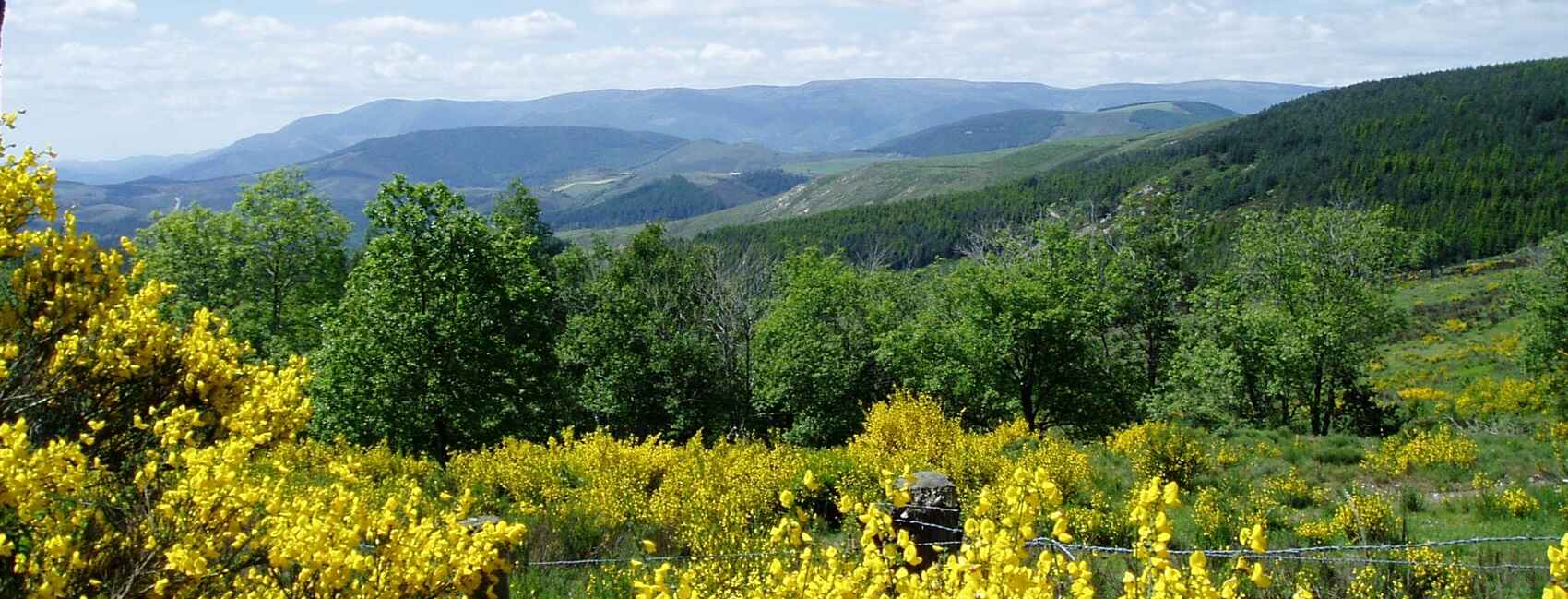
Which other region offers the traveler as many natural beauties, as many lessons from History, and as many chances for peace? - Andre Chamson
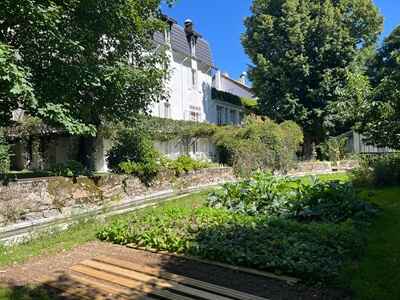 We depart from La Bastide-Puylaurent, perched at 1016 meters above sea level, with our starting point established at the guesthouse L'etoile. Philippe Papadimitriou always offers a warm welcome there. The quaint village, peaceful on the banks of the Allier, slowly fades away as we follow the markers for the GR®7 and GR®72. To the East, these trails will lead us to the abbey of Notre Dame des Neiges, but we choose to avoid it for now, preferring to reserve this discovery for our return. We quickly leave the white and red markers to climb to the summit of Felgere, at 1225 meters. From the top, the panorama opens up to Luc, our next destination, while the relief of the upcoming stages unfolds. Captivating perspectives await us.
We depart from La Bastide-Puylaurent, perched at 1016 meters above sea level, with our starting point established at the guesthouse L'etoile. Philippe Papadimitriou always offers a warm welcome there. The quaint village, peaceful on the banks of the Allier, slowly fades away as we follow the markers for the GR®7 and GR®72. To the East, these trails will lead us to the abbey of Notre Dame des Neiges, but we choose to avoid it for now, preferring to reserve this discovery for our return. We quickly leave the white and red markers to climb to the summit of Felgere, at 1225 meters. From the top, the panorama opens up to Luc, our next destination, while the relief of the upcoming stages unfolds. Captivating perspectives await us.
Our forest path heads East, almost following the ridge to a true crossroads of trails. A new view allows us to glimpse the last stages through the relief of the Ardeche mountains, promising both intense efforts and numerous pleasures. We now take the Tour of Tanargue, following the yellow and red markers. This path continues to wind under the beeches of Moure de Manibles before descending towards Laveyrune. There, we cross the GR®70, the Stevenson Path, which we follow backward to our stop.
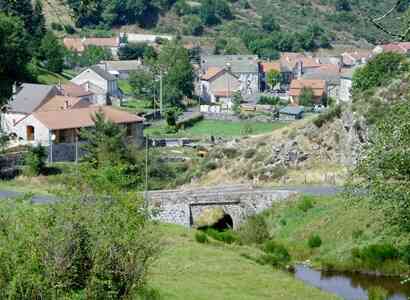 A short paved section takes us through the village and along the D.906, winding by the Allier. We quickly leave the road to climb towards Luc, a small village hanging on the valley slope. The place is charming: a beautiful Romanesque church stands in the heart of the hamlet, while the ruins of a medieval castle dominate the hill, overlooked by an imposing statue of the Virgin. It is here that we take a well-deserved break on the sunny terrace overlooking the Allier.
A short paved section takes us through the village and along the D.906, winding by the Allier. We quickly leave the road to climb towards Luc, a small village hanging on the valley slope. The place is charming: a beautiful Romanesque church stands in the heart of the hamlet, while the ruins of a medieval castle dominate the hill, overlooked by an imposing statue of the Virgin. It is here that we take a well-deserved break on the sunny terrace overlooking the Allier.
After a hearty meal, we enjoy a leisurely digestion in the tranquility of the Gardille forest, by a charming little lake. We brush past Les Pradels, as dark clouds gather on the horizon, then we surpass the deep valley of Langouyrou, where a quick descent to the stream is followed by a steep climb to reach the last hill. We arrive at the picturesque village of Cheylard-l'Evêque.
As light mists float over the hilltops, a still shy sun makes its appearance, dissipating the memories of yesterday's storm. Can one really tire of these early morning departures, imbued with freshness and promise? We set off, light-hearted, eager for landscapes...
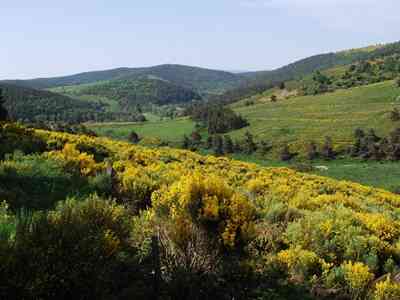 This stage announces a long forest hike through Moure de la Gardille and the Montagne du Goulet. Numerous elevations and vast horizons await us.
This stage announces a long forest hike through Moure de la Gardille and the Montagne du Goulet. Numerous elevations and vast horizons await us.
We begin with a pleasant and gentle ascent through the vast forest of Mercoire. The trail, from the Valley and Gorges of the Allier, is discreet, yet the route is clear to reach the heather moorland that surrounds Moure de la Gardille, the highest point at 1503 meters. This summit neighbors the sources of the Allier and the Chassezac, like a natural water tower. We join the GR®7, whose markers will guide us to the next step.
Now, a long descent allows us to cross the wide plain that borders the Chassezac. Just after Les Chazeaux, the big challenge of the day looms: the ascent to the mountain of Goulet. This final climb is steep but allows us to reach the summit (1497 m), where we enjoy a moment of tranquility in the heart of the forest. After a busy morning, the afternoon offers us a peaceful stroll on the southern slope of Goulet. We leisurely descend through the undergrowth as September begins its decline on the fireweeds. Before us rises the Lozere massif, our playground for the days to come. Today, we descend into the still fresh Lot Valley to reach Bleymard.
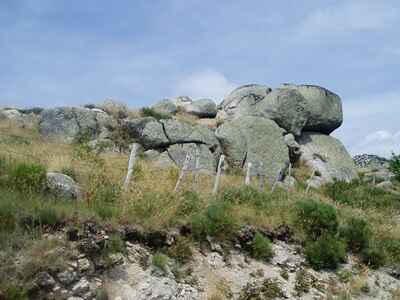 Many regions remain unexplored, so many trails remain unknown. Yet, I never tire of traversing the Massif Central, returning to the wild spaces of Mont Lozere, exploring the paths and trails winding through the Cevennes hills.
Many regions remain unexplored, so many trails remain unknown. Yet, I never tire of traversing the Massif Central, returning to the wild spaces of Mont Lozere, exploring the paths and trails winding through the Cevennes hills.
This corner of France preserves its identity, its austere soul. Resistance, isn’t that the very nature of the Cevenols? A centuries-old struggle to shape this harsh land and survive; a fierce resistance against the dragons of Louis XV, the Nazi occupier, and the uniformity of modernism. Andre Chamson, in L'Esprit des Cevennes, perhaps enlightens us: more than the beauties of nature and the lessons of History, what is offered to us in these valleys and hillsides, on these slopes and summits, is a quality of silence, a chance for peace almost unattainable nowadays. The spirit of the Cevennes is perhaps the conquest of inner serenity, through the tumult of nature and history.
I feel a deep attachment to the high, arid lands of the Causses and those surrounding the Mont Lozere massif: a rugged granite plateau, a labyrinth of valleys, islands of hamlets nestled in the infinite undulations of the ridges. I traversed them in spring, when winter unfurls its last throes; I remember an unexpected awakening in Barre des Cevennes, buried under a blanket of snow. I also admired the spring brilliance of gorse and the splendor of carpets of daffodils. More recently, I discovered the decline of summer there, as autumn begins to color the chestnuts gold.
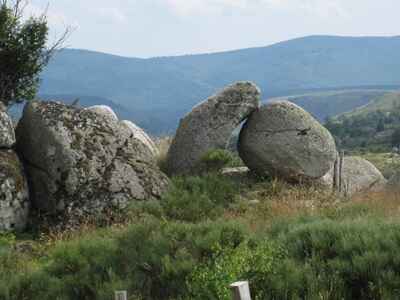 Today, we begin our wanderings in the Mont Lozere massif. A day is enough to make a North-South crossing, but having already done so, we wish to explore this vast mountain from East to West. This morning, we approach it with a circular route: with the GR®44 and GR®68, we follow the foothills of the Lot. The few hamlets become increasingly rare, like Orcieres and Lozerette. We cross a ravine, deep and wild, to reach Oultet, perched on the ridge of the cliff, where a few sturdy houses with slate roofs stand proudly. It is better not to get lost here in fog or snow. The end of our stage leads us to the southern slope of the massif. Shortly after the memorial cross of the tragically lovesick shepherd, the path leads us to the hamlet of Laubies. An old church, a welcoming inn, and a few houses nestled at the foot of a granite scree. On the terrace of the inn, we enjoy an aperitif facing a pastoral landscape, embracing the pyramid of Cham des Bondons and the cliffs of Causse Mejean.
Today, we begin our wanderings in the Mont Lozere massif. A day is enough to make a North-South crossing, but having already done so, we wish to explore this vast mountain from East to West. This morning, we approach it with a circular route: with the GR®44 and GR®68, we follow the foothills of the Lot. The few hamlets become increasingly rare, like Orcieres and Lozerette. We cross a ravine, deep and wild, to reach Oultet, perched on the ridge of the cliff, where a few sturdy houses with slate roofs stand proudly. It is better not to get lost here in fog or snow. The end of our stage leads us to the southern slope of the massif. Shortly after the memorial cross of the tragically lovesick shepherd, the path leads us to the hamlet of Laubies. An old church, a welcoming inn, and a few houses nestled at the foot of a granite scree. On the terrace of the inn, we enjoy an aperitif facing a pastoral landscape, embracing the pyramid of Cham des Bondons and the cliffs of Causse Mejean.
The beautiful weather continues, it is Indian summer at its peak. We therefore resume our way, joyful and light, to frolic on the ridges of Mont Lozere. Leaving Laubies, we ascend the southern slope of the massif. A brief forest crossing leads us to the road of the Unemployed, at the foot of the rock of Laubies (1562 m). We make our way through the pastures, in the company of red cows and the wind. Under a blue sky, we walk as a sea of fog engulfs the Tarn Valley. Soon, we leave the pastoral path to cut through the fields towards the signal of Laubies (1657 m). A path marked by modest cairns guides us through the undulations of the mountain, a most pleasant course on the humped back of the massif. I thank the gods of Mont Lozere who have always filled me with this clear sky.
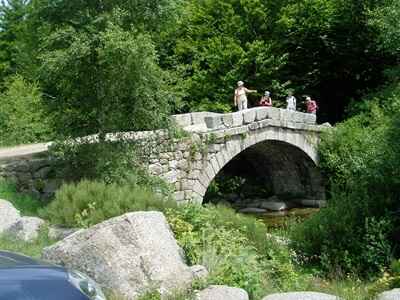 The summit of Finiels (1699 m) is the highest point of the massif, a natural lookout dominating the valleys and ridges that outline the tormented physiognomy of Lozere. It is not surprising that this department is the least populated in France; it is also not surprising that this desert is a true paradise for hikers! Beyond the band of coniferous forest and clusters of deciduous trees, we discover a mineral universe. Finiels is just a few steps away, but the landscape there is pleasantly harsh and wild, crushed by the heat. We take a well-deserved break on the edge of the hamlet, in the heart of a granite chaos, between rolled blocks and remnants of monumental erosion.
The summit of Finiels (1699 m) is the highest point of the massif, a natural lookout dominating the valleys and ridges that outline the tormented physiognomy of Lozere. It is not surprising that this department is the least populated in France; it is also not surprising that this desert is a true paradise for hikers! Beyond the band of coniferous forest and clusters of deciduous trees, we discover a mineral universe. Finiels is just a few steps away, but the landscape there is pleasantly harsh and wild, crushed by the heat. We take a well-deserved break on the edge of the hamlet, in the heart of a granite chaos, between rolled blocks and remnants of monumental erosion.
The path resolutely heads South, weaving between meager pastures where cows are scattered among the rocks. We cross the Rieumalet stream and plunge into its ravine, experiencing its coolness. There is no rush: the afternoon sparkles and the end of our journey is very near. We only have to descend to Pont-de-Montvert, nestled on the banks of the Tarn. The village seems to be entering a languorous sleep.
In Pont-de-Montvert, we are truly in Protestant territory. The temple testifies to this: its austere architecture reflects the Cevenole soul, just like the nobility of the pulpit carved from wood, a legacy of the spirituality of the Camisards. Neither the king's dragons nor his galleys have ever been able to uproot the Reformed faith from these hills. This village was the cradle of the Camisard war, which bled and burned the Cevennes in the early eighteenth century.
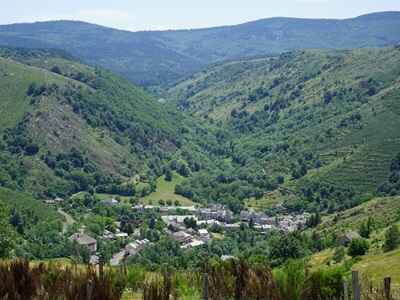 It is here that a group of Protestants, led by Pierre, nicknamed "Esprit," Seguier, assassinated Abbe du Chayla, the leader of the fight against the Reformed faith. However, the royal troops quickly captured the leader. Justice was swift: Pierre Seguier was tried in Florac and executed at Pont-de-Montvert, at the foot of the Clock Tower, which still stands proudly near the old bridge.
It is here that a group of Protestants, led by Pierre, nicknamed "Esprit," Seguier, assassinated Abbe du Chayla, the leader of the fight against the Reformed faith. However, the royal troops quickly captured the leader. Justice was swift: Pierre Seguier was tried in Florac and executed at Pont-de-Montvert, at the foot of the Clock Tower, which still stands proudly near the old bridge.
Here begins a long and magnificent stage, one of the highlights of our hike. It starts, however, with a stretch of asphalt, but this quiet little road along the Tarn makes for a pleasant morning warm-up. We quickly leave the D.998 to climb towards Merlet. Thus, we return to the stony paths of Mont Lozere. At Felgerolles, we find the markers for GR®72 and begin a rocky ascent through a granite chaos, a setting that is both harsh and wild.
On the banks of the Tarn, the landscape begins to open up to the vast desert expanse of the southern slope. A tranquil stroll along the river, now calmed after the spring heat. The site of Pont du Tarn retains all its charm. The beautiful Romanesque arches of the old bridge span the crystalline waters dotted with granite blocks, evoking the peaceful history of the transhumants who once stopped here in the shade of the pines.
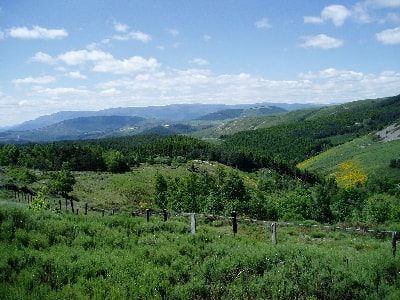 We continue eastward. The GR®72 grazes the forest before finding the stony moorland where the sources of the Tarn spring forth. The hamlet of Bellecoste, in poor condition, testifies to the agony of the sturdy granite buildings. The Lozere massif returns to the tranquility of the desert. Even the transhumant herds seem to be scarce here, but a young couple is busy restoring one of the houses, perhaps seeking the solitude of a summer residence. Yet, "one swallow does not make a spring!"
We continue eastward. The GR®72 grazes the forest before finding the stony moorland where the sources of the Tarn spring forth. The hamlet of Bellecoste, in poor condition, testifies to the agony of the sturdy granite buildings. The Lozere massif returns to the tranquility of the desert. Even the transhumant herds seem to be scarce here, but a young couple is busy restoring one of the houses, perhaps seeking the solitude of a summer residence. Yet, "one swallow does not make a spring!"
The dirt road winds below Pic Cassini (1680 m), the second highest peak of the massif. We re-enter the forest before reaching Mas de la Barque (1420 m). The lodging is situated in the heart of a sunny glade, inviting us to enjoy a blonde beer. The sandwiches, also generous, prove to be delicious.
The afternoon promises to be quiet: the guidebook indicates 11 km to Villefort (Regordane Way GR®700 or Chemin de St Gilles), at the bottom of the valley, with a 800-meter elevation change. Beware of hasty judgments! Certainly, we descend through the forest and twirl around to risk getting lost. But there are also climbs, like on this rocky ridge leading to Bousquillou (1115 m).
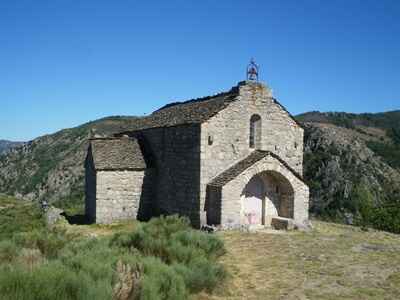 There, we finally leave the cover of the underbrush to regain broad horizons. And what horizons! To the West, Mont Lozere stretches its spine above the meager hamlets. To the East, the Ardeche mountains exhibit their jagged relief, promising days without boredom. Come on, we have already seen beautiful landscapes. Let’s relish the pleasure of walking along the panoramic ridge of Plo de la Voulp before finally plunging down towards Villefort.
There, we finally leave the cover of the underbrush to regain broad horizons. And what horizons! To the West, Mont Lozere stretches its spine above the meager hamlets. To the East, the Ardeche mountains exhibit their jagged relief, promising days without boredom. Come on, we have already seen beautiful landscapes. Let’s relish the pleasure of walking along the panoramic ridge of Plo de la Voulp before finally plunging down towards Villefort.
The night promises to be lively: the next day, the village organizes a hikers' brevet. The lodging is packed with cheerful walkers celebrating their feats… in advance.
This day constitutes a transition stage between the Lozere massif and the Vivarais Cevennes. Moreover, part of the morning will have no other appeal than the tranquility of the forested hills, after the close quarters of the lodging. As we exit Villefort, the GR®44 climbs into the forest and lingers there without offering the slightest glimpse of the valleys, barely discernible on either side of the ridge.
Let’s be fair: we enjoy the shade and coolness of the underbrush, as the sun is still benevolent. Who could complain? The locals, no doubt, overwhelmed by long months of drought!
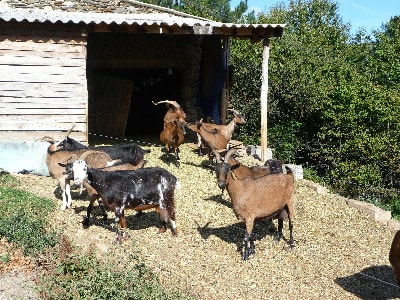 The morning is already well underway when we leave the forest at Croix de la Rousse to tackle the rocky ridge of Serre de Barre. The walking becomes chaotic: we scramble over this jagged and bushy ridge. It feels like we have taken to the maquis.
The morning is already well underway when we leave the forest at Croix de la Rousse to tackle the rocky ridge of Serre de Barre. The walking becomes chaotic: we scramble over this jagged and bushy ridge. It feels like we have taken to the maquis.
But what a landscape awaits us this time!
To the right, the Cevennes ridges undulate infinitely towards Aigoual; to the East, we soar over the Ardeche plateau to the bluish horizon where Ventoux looms. This famous viewpoint allows us to embrace a vast horizon! We thus treat ourselves to a well-deserved panoramic snack.
At the southern spur of Serre de Barre, we begin a long descent. The old rocky path, sometimes bordered by low walls, tumbles through the bushes of the slope. A pause on the road, and we plunge back towards Brahic, where the hamlet dozes in a Sunday nap. The beneficial fountain calls to us, and we take refuge for a moment in the cool shadow of the old church with its comb-like steeple.
There are still 300 meters to descend through the rubble to reach Les Vans (GR®4, GR®44, and Le Cevenol). Vineyards at the foot of the hills, plane trees lining the streets: we are indeed in the Midi. The village savors this end of the weekend on its terraces. We look a bit "masochistic" carrying our gear, but we have treated ourselves to pleasures more intense than sipping a pastis!
 We begin by lingering on the banks of the Chassezac, beyond Chambonas and its castle, then we return to the hills with Le Cevenol. Gently at first, without any brutality. We ascend slightly along good paths with a Mediterranean character, winding along a long ravine, crossing underbrush of pines, with some vineyards near the peaceful hamlets we brush by. "Too late for the harvest!" a farmer jovially calls out to us. Yet, some delightfully sweet bunches have survived.
We begin by lingering on the banks of the Chassezac, beyond Chambonas and its castle, then we return to the hills with Le Cevenol. Gently at first, without any brutality. We ascend slightly along good paths with a Mediterranean character, winding along a long ravine, crossing underbrush of pines, with some vineyards near the peaceful hamlets we brush by. "Too late for the harvest!" a farmer jovially calls out to us. Yet, some delightfully sweet bunches have survived.
After Les Aliziers, the trail becomes tougher. The stony paths climb steep wooded hills, while we tumble down a ravine only to climb back up vigorously. We chain the ascents only to lose altitude immediately. In this roller coaster game, when will we reach the 900 m of the Vivarais Cevennes cornice? We conclude a heavy morning scrambling through the rubble, among dilapidated walls. The rustling of chestnut leaves mingles with the clattering of stones.
We take our midday break in Saint-Jean-de-Pourcharesse. The small square, serving as a forecourt to the old Romanesque church (yet another beautiful comb-like steeple), will do just fine. Not a soul in sight. In the neighboring house, the radio or television drowns out the occupants: despite our knocking on the door or shutters, in the end, not a single fountain to fill up with fresh water! From this terrace, the landscape is more generous than the inhabitants.
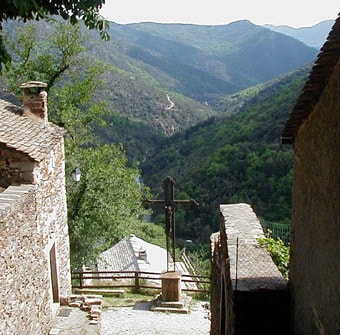 The afternoon reserves a tough piece for us, yet another good stretch of roller coasters where the ascent takes precedence. The old rocky path guides us through bushy hills. In the lost hamlet of Depoudent (700 m), we have a good effort left to reach the 865 m of Peyre: the midday sun floods these rocky hills, stingy with shade. Yet, the beauty of the landscape compensates for the fatigue: as we descend a path, we dive into the scenery, discovering the long spine overlooking the Chassezac ravine, a retrospective look at our previous stage. And at the bend of a hairpin, the tiny hamlet of Thines reveals itself, the long-anticipated end of this tough day. This stage will undoubtedly mark our memories, Thines clinging to a rocky spur, precariously perched above a dizzying ravine.
The afternoon reserves a tough piece for us, yet another good stretch of roller coasters where the ascent takes precedence. The old rocky path guides us through bushy hills. In the lost hamlet of Depoudent (700 m), we have a good effort left to reach the 865 m of Peyre: the midday sun floods these rocky hills, stingy with shade. Yet, the beauty of the landscape compensates for the fatigue: as we descend a path, we dive into the scenery, discovering the long spine overlooking the Chassezac ravine, a retrospective look at our previous stage. And at the bend of a hairpin, the tiny hamlet of Thines reveals itself, the long-anticipated end of this tough day. This stage will undoubtedly mark our memories, Thines clinging to a rocky spur, precariously perched above a dizzying ravine.
The hamlet? A handful of old schist and slate houses clustered around an unexpected Romanesque church in this corner of the Ardeche Cevennes.
At the heart of these wild hills stands a masterpiece of Romanesque architecture: a harmony of forms and a subtle arrangement of materials, alternating gray, pink, and white stones in a refined mosaic. By what miracle did the men of the Middle Ages, in the 12th century, build this work of art in such solitude? Did this lost hamlet once experience significant economic activity to allow the construction of this religious monument? Today, it loses its arms and its soul, as Germans and Dutch buy these old houses at a high price, inaccessible to the locals. The closed shutters of the restored homes sink into the long sleep of dying villages. How many times have we crossed, on the causses, on the slopes of Mont Lozere, in the lost valleys of Herault or Drôme, these vestiges of a rural civilization?
This stage will undoubtedly mark our memories as one of the wettest and most tumultuous we have ever experienced. My memories are summed up as a frantic rush through thick fog, the rain drumming on our capes, while the storm resonated its fury above our heads. Instead of the majestic landscapes promised by the guidebook – which proudly claimed "magnificent views" – I only retained the violence of the elements, brutal but strangely captivating sensations. Was it reasonable to linger on this desolate ridge, skirting the pylons of a high-voltage line, feet soaked by a torrent of mud, surrounded by the deluge and illuminated by lightning? But what else could I do in this solitude, with our lodging reserved... and that indelible streak of recklessness that inhabits us, despite the weight of the years?
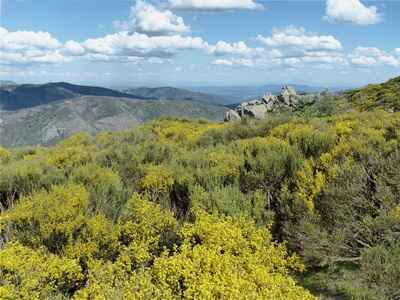 It takes some madness to leave the cozy cocoon and frolic like this on paths worn by all weathers. We were in search of authentic emotions, the surprises that modern life denies us. Along the way, we encountered a quartet of reckless souls, also seeking an aquatic escape under the same deluge.
It takes some madness to leave the cozy cocoon and frolic like this on paths worn by all weathers. We were in search of authentic emotions, the surprises that modern life denies us. Along the way, we encountered a quartet of reckless souls, also seeking an aquatic escape under the same deluge.
Fortunately, this stage was the shortest of the circuit. I had planned a small detour off the beaten path, a panoramic path circling the Pratauberiat massif... but in the end, we decided to stick to the classic route. A bit crazy, certainly, but not completely insane! Thus, we escaped the fury of the storm, although it did not protect me from one last electric shock: there I was, dripping and blinded, rushing into an electrified fence at the entrance of Loubaresse. A rather striking sensation, I assure you!
My worried gaze scanned the horizon, searching for a glimmer of hope. The village was drowned in fog, submerged in a gloomy procession of clouds. But we’ve seen worse, and the rain eventually subsided. This heavy sky, where veils of mist floated, enveloped the moor of the Pratauberiat pass in an uncertain, almost desolate atmosphere.
We then crossed a forest, leading to Chambons. It was then that a question arose: should we take the ridge route of GR®7 or GR®72, which follows the valley of Borne? Having already been spoiled with panoramas, and with uncertain weather conditions, we opted for GR®72. A wise choice, as this path quickly proved to be wild and picturesque.
 Barely had we traveled a short stretch of asphalt, flanked by mulberry bushes – a beautiful setting concealing a deep precipice – when the stony path began to wind along the ravine. Below, the Borne rumbled, tumultuous, swollen by the deluge from the previous day. The switchbacks descended into the canyon, offering spectacular views of the torrent. Even a ruined tower added to the scene, lending a touch of romance to the decor. The hamlet of Borne, for its part, only extended this atmosphere. It was home to a handful of houses and some remnants, witnesses to a past that seemed glorious. A beautiful granite porch, adorned with an enigmatic word and an ancient date, "1667," recalled those bygone times.
Barely had we traveled a short stretch of asphalt, flanked by mulberry bushes – a beautiful setting concealing a deep precipice – when the stony path began to wind along the ravine. Below, the Borne rumbled, tumultuous, swollen by the deluge from the previous day. The switchbacks descended into the canyon, offering spectacular views of the torrent. Even a ruined tower added to the scene, lending a touch of romance to the decor. The hamlet of Borne, for its part, only extended this atmosphere. It was home to a handful of houses and some remnants, witnesses to a past that seemed glorious. A beautiful granite porch, adorned with an enigmatic word and an ancient date, "1667," recalled those bygone times.
The path delved under a cover of greenery, fording small streams, tributaries of the Borne, before reaching the crumbling houses of Conches. I learned, during our next stop, that an old lady clung to these ruins until her recent death. But how did these lost souls manage to live, in this rocky and wild environment? While our opulent society flails over minor financial trifles, these inhabitants likely led a rudimentary, laborious existence, wrested from nature. The paths that offer us sometimes spectacular changes in scenery also plunge us into the history of these men, for our reflection... and perhaps our wisdom?
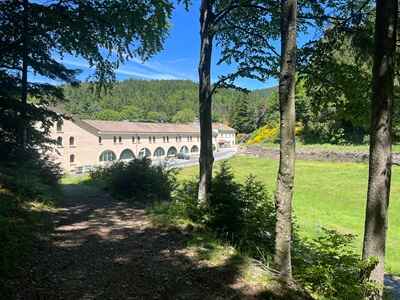 Then, the path took us away from the ravine of Borne, suddenly gaining altitude before plunging toward Saint-Laurent-les-Bains. A pretty village, with its small church featuring bright modern stained glass. Here, spa-goers rush to enjoy the virtues of the thermal springs, whose water, bubbling at 53°C, is miraculous against rheumatism. We are not yet at such medicines, preferring a well-known saying: "One day of path, ...". Quickly, as we exit the village, we faced a 350-meter elevation change to dominate the high tower of Saint-Laurent and reach the cross of Pal. We moved at a brisk pace, as the thunder rumbled and the sky grew darker still.
Then, the path took us away from the ravine of Borne, suddenly gaining altitude before plunging toward Saint-Laurent-les-Bains. A pretty village, with its small church featuring bright modern stained glass. Here, spa-goers rush to enjoy the virtues of the thermal springs, whose water, bubbling at 53°C, is miraculous against rheumatism. We are not yet at such medicines, preferring a well-known saying: "One day of path, ...". Quickly, as we exit the village, we faced a 350-meter elevation change to dominate the high tower of Saint-Laurent and reach the cross of Pal. We moved at a brisk pace, as the thunder rumbled and the sky grew darker still.
As we descended the Rieufrais valley, we reached the abbey of Notre-Dame-des-Neiges just before the first drops began to fall.
Founded in the 19th century by Cistercian Trappists, it was rebuilt after a fire in 1912. It is here that Robert Louis Stevenson stopped during his journey through the Cevennes. But it is undoubtedly Charles de Foucault who has left an indelible mark on the history of this abbey. After his novitiate, he was ordained a priest there before embarking for the Sahara. During World War II, the community even sheltered clandestine operatives, including Robert Schuman. Today, the monks cultivate vines and produce a very decent table wine from grapes from the Midi.
We could not linger at the Trappe: the rain does not seem like a passing visitor. It was just the "tail" of the storm, and we had three good kilometers left to complete our final stage. In a flash, we sped through the valley of Rieufrais. L’etoile awaited us, still welcoming and comfortable. Philippe Papadimitriou would be delighted to take us to the Trappe for a tasting of the carefully crafted wines. A joyful crowning of our Cevennes adventure! Christian Lalanne
Former holiday hotel with a garden along the Allier, L'Etoile Guest House is located in La Bastide-Puylaurent between Lozere, Ardeche, and the Cevennes in the mountains of Southern France. At the crossroads of GR®7, GR®70 Stevenson Path, GR®72, GR®700 Regordane Way, GR®470 Allier River springs and gorges, GRP® Cevenol, Ardechoise Mountains, Margeride. Numerous loop trails for hiking and one-day biking excursions. Ideal for a relaxing and hiking getaway.
Copyright©etoile.fr